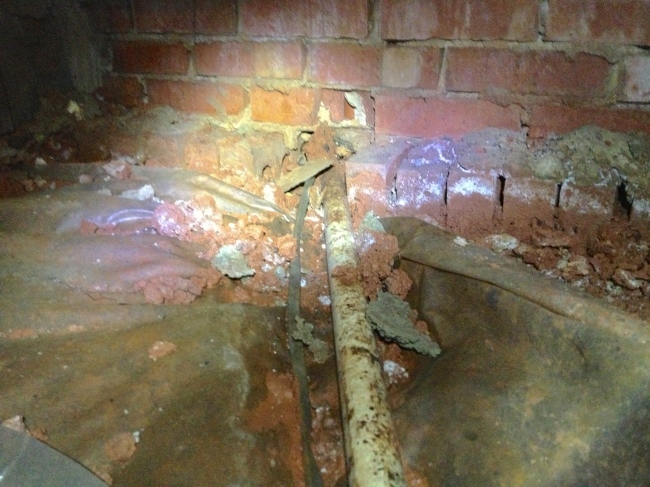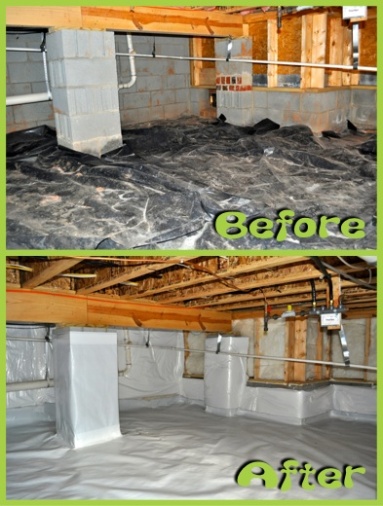I used to think that houses smelled musty because they were old, or because they had old things in them. Now I know that smell is often a symptom of something worse. The most common cause of a musty smelling house is the crawl space. Due to the stack effect, approximately 40% of the air you breath in your home originates in your crawl space. If your crawl space is moldy then the air in your home will be moldy. So I was partially right when I used to think that houses smelled musty because they were old.
The truth is that many homes in North Carolina built prior to 2004 are not properly waterproofed. Therefore many of them have a moisture issue in the crawl space which can lead to a mold issue in the crawl space. And when you have a mold issue in the crawl space you often have a musty smell in the home.
So if the air in your home seems stale or smells musty, take a peek in your crawl space. Better yet, contact Green Frog Waterproofing for a free inspection. It could literally lead to a breath of fresh air.
Green Frog is here to "Protect your Pad." We hope this blog provides some helpful info and resources as you protect your pad against the destructive forces of water. Feel free to comment or contact us directly if you would like more information.
Thursday, January 23, 2014
Wednesday, January 8, 2014
5 Winter Tips for a Healthy Home
There are a few winter tips that (almost) everyone knows, such as opening your blinds when the sun is shining, closing your front door, and not leaving the fridge open ... but we won't mention those here. Here are some lesser known tips that might end up saving you a lot of money and headache this winter.
1. Don't leave it out in the cold.
2. Open or closed?
3. Did you know?
5. I feel a draft!
1. Don't leave it out in the cold.
If your hot water heater is in your attic or garage, it is a good idea to wrap it with insulation to not lose heat.
2. Open or closed?
It is usually best to open your crawl space vents during the dry winter months to help dry out your crawl space. The one exception is when it is so cold that your pipes could freeze. But that is unlikely in the Carolinas. The geothermal heat rising from the ground under your house is usually enough to keep your crawl space above freezing, and if you have a gas furnace it will also give off enough radiant heat to keep your crawl space above 32 F.
3. Did you know?
Condensation (which can lead to mold) is usually thought of as a summer problem. But condensation can happen in your crawl space wherever warm and cold air mix. It can happen in the winter if your crawl space is warm and cold air is being sucked in through the vents.
4. Who turned out the light?
Check your crawl space regularly to ensure that bulk water is not present. Aside from causing other problems such as mold and structural damage, water can extinguish your furnace’s pilot light which can lead to carbon monoxide being leaked into your home.4. Who turned out the light?
5. I feel a draft!
If you feel a draft on your first floor, there is a good chance it is coming from the crawl space. Draftiness or cold patches are often due to missing insulation or utility penetrations created in the sub floor during construction. Other than leaving your front door open, the crawl space is the easiest (and most often overlooked) way for cold air to sneak in. The best way to keep this from happening is to seal or encapsulate your crawl space. By sealing out all the outside air and insulating the walls, a sealed crawl space drastically improves the indoor air quality and energy efficiency or your home.
Thursday, January 2, 2014
6 Ways to Keep your Crawl Space Dry
1. Keep outside water out
A few steps should be taken to prevent water from the outside of your home from having an easy opportunity to make it’s way into your crawl space. Extend your gutters (above or below ground) away from your foundation. Make sure that you have at least 5% grade falling away from your foundation so that water can easily flow away from your home. Seal below ground penetrations in your foundation wall that were created during the construction process. A thorough inspection by our Moisture Intrusion Technicians can reveal these penetrations.
2. Adequate vapor barrier
The floor of your crawl space should be 100% covered with a minimum 6 Mil plastic barrier. This barrier can be upgraded by installing a thicker plastic and/or taping the seams. A thicker plastic can add to efficiency and longevity of your vapor barrier.
3. Waterproof the outside of your home
You can prevent water from seeping through the foundation walls by waterproofing the exterior surface of your crawl space walls. This process should be performed by a professional as it involves excavating the earth beside the wall, cleaning the wall, applying a waterproof membrane, and possibly installing a drain beside the footer.
4. Install a french drain and sump pump
It is not always ideal to excavate and waterproof the exterior of the home. In this case the water can be controlled by installing an interior French drain that moves the water out of the crawl space. Depending on the terrain of your yard, a French drain may also need to be installed in conjunction with a sump pump.
5. Install a dehumidifier
A dehumidifier can keep the humidity level low and reduce the chances of mold, but keep in mind that you will also need to seal any possible openings that can allow humid air to enter. Otherwise you will be unsuccessfully attempting to dehumidify your neighborhood! A few common culprits are the crawl vents, lack of a tight seal on the crawl door, and small holes in the masonry wall around wires, cables, and plumbing lines.
6. Seal (encapsulate) the entire crawl space
The best case scenario for maintaining an ideal humidity level in your crawl space is to seal or encapsulate the crawl space. A crawl space that is sealed properly will not allow any outside humidity to enter the crawl, creating a clean and dry environment. A sealed crawl space improves your home’s indoor air quality, improves the efficiency of your HVAC system, as well as creates an ideal environment for storage.
Subscribe to:
Posts (Atom)


